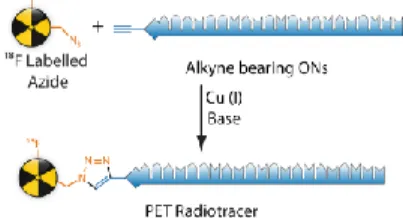.
Universal solid support synthesis
of modified oligonucleotides labeled
by click chemistry for PET studies
Flagothier J, Mercier F, Kaisin G, Thonon D, Lemaire C, Luxen A. Cyclotron Research Center, Liege University, Sart-Tilman B.30, B-4000 Liege, Belgium
jflagothier@ulg.ac.be
I
N
T
R
O
D
U
C
T
I
O
N
R
E
S
U
L
T
S
Positron emission tomography (PET) is a high-resolution, sensitive, functional imaging technique that permits repeated, non invasive assessment and quantification of specific biological and pharmacological processes in humans.[1]Fluorine-18 appears often as the radionuclide of choice for the preparation of short-lived positron-emitter radiotracers due to its physical and nuclear characteristics.[2] Fluorine-18 labeling of biomolecules such as peptides,[3]oligosaccharides, and oligonucleotides[4] (ONs) requires very mild reaction conditions. Today, the method of choice for a highly efficient fluorine-18-labelling of ONs is the conjugation of a prosthetic group, carrying the radioisotope, with a reactive function of the ONs.
For the conjugation reaction of the prosthetic group with the ON, we selected click reaction and more specifically the Cu(I) catalyzed formation of 1,2,3-triazole using Huisgen 1,3-dipolar cycloaddition of terminal alkynes with azides. This reaction is highly regioselective leading to 1,4-disubstituted 1,2,3-triazoles and can be performed in different solvents
Figure 1 : Coupling between ONs and prosthetic group using click
chemistry.
with very high yield.[5-7] Conjugations with ONs are usually performed at 3’-ends using a well chosen linker in order to limit degradation by exonucleases.[8]Here we report the synthesis of an alkyne-bearing linker which can be attached at 3’-ends to any sequence of ONs.
We have prepared a new universal linker which allows the introduction of an alkyne function at the 3’-end of ON. This alkyne modified ON can then react under click conditions with an azide function of a prosthetic group carrying the fluorine radioisotope, the 1-(azidomethyl)-4-[18F]-fluorobenzene which is obtained using a remote controlled synthesizer.
DMTrO O N H O DMTrO O N H OH O O OH O O O Pyridine 55°C, 5h O OH O MeOH, 60°C, 48h NH2 DMTrCl Pyridine, 12h 1. 2. DMAP 2 1 3
The linker 3 was prepared in three steps from commercially available (R)-(+)--hydroxy- -butyrolactone 1 with overall yield of 29% (Scheme 1).
NH2 + DMTrO O N H O O O OH N H O O O O N H ODMTr TBTU 3 4
Controlled-pore glass (CPG) solid support was functionalized by coupling between resin and the compound 3 using TBTU as coupling agent for amide formation (Scheme 2). The ON synthesis can be directly realized on the modified solid support 4 and finally, after cleavage with MAM solution, we obtained the ON 6 modified by the linker 2 (Scheme 3).
Scheme 1 : Synthesis of alkyne-bearing linker
N H O O O O N H ODMTr N H O O O O N H O Oligonucleotide HO O N H O dsRNA 4 5 6 NH3/MeOH MeNH2 duplex formation Scheme 2 : Functionalization of CPG solid support
Scheme 3 : Synthesis of the modified oligonucleotide
Scheme 4 : Click reaction
Acknowledgments
To obtain the [18F]ON 7, a click chemistry reaction was used (Scheme 4). The prosthetic group used is the 1-(azidomethyl)-4-[18F]-fluorobenzene.[9]
References
We gratefully acknowledge Dr N. Teller (Eurogentec, Liège, Belgium) for the support about ONschemistry and the solid support functionalization and the Région Wallone for financial support (OligoPETprojects).
[1]: Schubiger P.A. et al.; Chem. Rev. 108: 1501-1516 (2008) [2]: Pike V.W. et al.; Eur. J. Org. Chem. 17: 2853-2873 (2008) [3]: Olberg et al.; Bioconjugate Chem. 19: 1301-1308 (2008) [4]: Viel T. et al.; J. Label. Compd. Radiopharm. 50: 159-1168 (2007) [5]: Kolb, H. C. et al.; Angew. Chem. Int. Ed. Engl. 40: 2004-2021 (2001) [6]: Gil, M.V. et al.; Synthesis 1589-1620 (2007) [7]: Victoria D. Bock et al.; Eur. J. Org. Chem. 51-68 (2006) [8]: Stetsenko D.A. et al.; Bioconjugate Chem. 12: 576-586 (2001) [9]: Thonon D. et al.; Bioconjugate Chem. 20: 817-823 (2009)
Labeling efficiency was checked by HPLC analysis (figure 2 and 3).
Figure 2: HPLC chromatogram
of the modified ON and the 19 F-ON
Figure 3: HPLC
chromatogram of crude 18F-ON mixture and cold
reference 19F-ON Cyclotron Research Center HO O H N O dsRNA HO O H N O dsRNA N N N CuSO4.5H2O/TBTA Sodium ascorbate, DMSO, H2O, tBuOH 15 min 18 F + N3 18F 6 7 18F N3 19F-7 19F-7 18F-7 6
